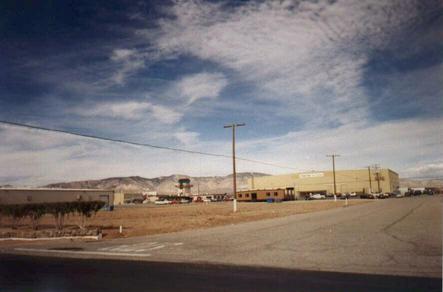Thirty-seven years ago today Astronauts Gus Grissom, Roger Chafee and Ed White died in an on the pad test of an Apollo capsule.
|
|||||
|
Ladies and gentlemen, this is what it looks like on Mars. That is the vista that will greet the first humans to set foot on that planet. I do not expect to be around to share in that experience but I still tingle with excitement at the prospect. It has been a busy couple of weeks: two proposals and the holiday season on top of it. It’s had me so tied up I am just now getting around to other matters. I’m ‘throwing my hat in the ring’ for the next National Space Society Board of Directors election. The time left for me to be included amongst the Board nominees is rather short. I need my signed petitions into the NSS office by midnight January 15th. I’ve already emailed petition forms to a bunch of folk, a few of which I know are also Samizdata readers. If you are not one of them (ie you didn’t just get an email from me) and know you will be a paid up member of the Society as of January 15th, 2004, please contact me via the comments section and I’ll send you a copy of the petition and related information. Note that attempting to send email directly to me will result in delays of a day or two as I have a white list which dumps all unexpected mail into a holding pen. While answering a comment I had a sudden realization: Scaled Composites is going to take the Triple Crown of aerospace. There are three top records in aviation. Distance. Speed. Altitude. The Scaled Composite built Voyager already holds the distance record with their around the world flight. SpaceShipOne is a 21st Century version of the X15, which holds the other two records. I think SpaceShipOne is going to take the altitude record off of it very soon. If it can do that, it may also be capable of taking the speed record in a different flight profile if it can avoid overheating. This is getting very interesting. I’ve finally got my hands on the Scaled Composites flight test report from Dec 17th, 2003:
Now hands up for everyone who believes NASA could return an unmanned children’s kite to flight in three weeks after a gear collapse… All going well, on December 25 at 2:45 am GMT, The Beagle 2 lander will touch down on the Isidis Planitia impact crater on the surface of Mars. This lander, which has a planned six month mission on the Martian surface, was developed and built in Britain and forms part of the European Space Agency’s Mars Express mission, from which Beagle separated on December 19. Mars Express will be inserted into Mars orbit at 3:00 am GMT on December 25 for a planned mission of between one and two years.  A mockup of the Beagle 2 lander at Sandy Quarry, Bedfordshire. (All rights reserved Beagle 2). All going well, Beagle will be followed by two identical American landers that are scheduled to land in January. These two Mars Exploration Landers will have wheels and will be fully mobile when they arrive, being able to travel distances of up to 40 metres per day. (Everything important is self-contained in the Rover, and the rest of the lander is just a delivery vehicle). Spirit will land in the Gusev Crater on January 4 at 4:35 am GMT on January 4, and Opportunity will land on Meridiani Planum on January 25 at 5:05 am GMT. If all three missions land successfully, we should be getting back lots of interesting data on the red planet.  Projection of the Mars Exploration Rover leaving the lander shell. (Copyright NASA/JPL). If all are successful (about which there is a caveat that I will get to in a moment) these will be the fourth, fifth and sixth successful lander missions to arrive on Mars, after Viking 1 and Viking 2 in 1976 and Mars Pathfinder in 1997. (I am excluding the Soviet Mars 3 mission from 1971 which transmitted data for only 20 seconds after an apparently successful landing). All three missions will use the landing method pioneered by Mars Pathfinder in 1997. → Continue reading: A very exciting year for planetary exploration Here are the official Press Releases. Microsoft billionaire Paul G. Allen has used the event as an opportunity to admit what everyone knew: he is the secret backer of the Rutan’s project. The second release is the official announcement of the flight, warts and all. They reached 68,000 feet after a 15 second burn and hit Mach 1.2 during the flight. I’m not all that surprised they went supersonic. I was thinking about the issue and suspected the thrust to weight on that craft is such they’d have little other choice for a serious test. I’ve been watching them gradually build up the test profile over the last couple months. Even so, I was a bit surprised to see the first powered flight of SpaceShipOne push the envelope as aggressively as it did. They have tested it several times in a sort of hammerhead stall if the picture I get from the test documents is right. They let it fall off the top in a stall and then recover control. The vertical stall at altitude is part of the testing for recovery of control on re-entry. As I understand it, they do not have an RCS (Reaction Control System, what you use when there ain’t no air for ailerons). If true, they will be more cautious as they begin probing non-aerodynamic altitudes as they are depending on the inherent balance of the ship to keep it facing forwards and rightside up. From here on out, they are reaching for Space. They’ll take SpaceShipOne higher and faster flight by flight until they finally put some vacuum under her tail. Those supporting the government position have said high costs are inherent in space flight. The short time scale, low costs and aggressive testing program of Scaled Composites should be an eye-opener to those nay-sayers. What I and others have been writing for nearly a quarter of a century is correct. The rocketmen are not underestimating the cost of space. It is the government and government contractors who have been “ripping the arse” out of the public purse. After twenty-five years of the blood, sweat and tears of pioneering rocketmen from Zaire to Matagordo Island to San Francisco Bay to Vandenberg we have proven our case. Scaled Composites is not alone. There are others close behind them. Many first flights will happen this decade in a reprise of the totally private aviation of 1903-1910. It is the end of the beginning and a marvelous time to be alive. Note: Doug Jones reports SpaceShipOne has a cold gas RCS. I find this very comforting. It is rather late here and I’ve had a flu bug all week… but I had to confirm and report this before I call it a night. One of our readers (Juliam Morrison) mentioned in comments that SpaceShipOne went supersonic. I’ve just chatted with Jeff Greason of XCOR, another Mojave denizen and confirmed it. On December 17th, 2003, SpaceShipOne dropped from the mother ship, lit the rocket engine and broke the sound barrier. The Space Age is about to begin. I probably won’t have the flight data for a couple days, but I’ll pull the press release tomorrow and post the info. Now, was I right or was I right? Scaled Composites carried out its seventh drop of SpaceShipOne on December 4th. According to the test report, pre-ignition propulsion system checks seem to be moving forward nicely:
December 17th is less than a week away, very close to two weeks from when this flight test occured. That is close enough to the intervals between the last three tests one could expect at least a drop test on the Wright Brothers First Flight date. I still think an in-flight engine ignition and a short burn is within the realm of possibility. Brian just posted one of my favorite shots of the Scaled Composites spaceship and wondered how large the windmills in the background windfarm are. The answer is: big. Here are two of my non-telephoto photos of roughly the same area as seen from within the confines of the Mojave Civilian Test Flight Facility (a couple hours travel north and east of Los Angeles, California):  Photo: Dale Amon, all rights reserved  Photo: Dale Amon, all rights reserved Yes, those are the same mountains you see in the photo on Brian’s blog. The windfarm was actually just barely visible in the top image before I cut it down to blog-size. I am far less certain of the direction of the bottom photo, but I think it shows the mountains in the opposite direction as I can see the control tower in it. (There is also an F4 Phantom. Can you find it?) Things tend to be very big and very far away in that part of the world! Meanwhile, Armadillo Aerospace has solved their H202 supply problems, has run a test engine at better than 1000lbf and good ISP and is working on vehicle modifications to deal with the new engine design. You can watch them testing the modified landing shock absorbers of their VTVL spaceship. Scaled Composites flew their sixth drop test on November 19th, less than a week after the previous flight on the fourteenth. Tests prior to this have been at roughly one month intervals so I assume they are entering a new phase of testing.
The odds for an in-flight engine ignition on December 17th are getting better again. It may now be a matter of how satisfactory the ground tests of the SpaceDev hybrid engine have been. |
|||||

All content on this website (including text, photographs, audio files, and any other original works), unless otherwise noted, is licensed under a Creative Commons License. |
|||||


